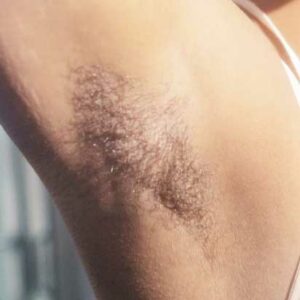Keep the Fur
Bushy armpits are back in vogue. Sophia Loren showed us how in 1955. Then Julia Roberts in 1999. Lady Gaga took it too far in 2011 with fake hair. In July, 2022, The Wall Street Journal headlined, “Armpit Hair Is Back, Whether You Like It or Not,” with a seductive picture of Ajani Russell displaying full mammalian armpits.
Humans are Mammals
What’s a Mammal?
It’s a warm blooded animal with a backbone (vertebrae), a hinged lower jaw, three bones in the middle ear, a diaphragm to breathe, mammary glands, and of course hair. Even whales have hair.
Why Hair?
The function of hair changed as mammals evolved into different environments. Whales ended up in the water where its purpose is a subject of inconclusive debate among scientists. Humans evolved into high rise apartments where hair became an ornament. Or lack of it became stylish.

Hair has a Purpose
Before thinking about hair, think about how lucky we humans are to live in high rise apartments, surrounded by stainless steel, eating at McDonald’s, and able to go to medical clinics now gracing almost every corner and mall in the country. If we are lucky, we can spend a week at Mayo Clinic to find out what’s “really” wrong with us.
Mayo Clinic offers the right answers: “Count on our experts to deliver an accurate diagnosis and the right plan for you the first time.”
We are not mocking Mayo Clinic, nor the medical profession. They are treating the symptoms of a problem they did not create. We should ask ourselves why healthcare in the United States has increased from 5% of gross domestic product (GDP) in 1960 to 18.2% in 2021.
We need the clinics to tell us why we have diabetes, high blood pressure, food intolerance, cancer, obesity, and acne!
The point is, as humans we are really messed up. We do a lot of things for the wrong reasons, like eating sugar and shaving armpits.
But why do we have Hair?
Ask a bald guy what it feels like to get hit on the head and be grateful if you have a full head of hair to cushion the blow. Great protection but the constant nagging question, “What should I do with my hair?” Only your hairdresser knows.
Evolution has given us armpit hair and pubic hair for reasons that are more subtle. To objectively know what we should do with our hair, it makes sense to understand why evolution left us with hair. Aside from the obvious reason that hair offers physical protection, some of the reasons we have it are speculative.
Armpit Hair and Pubic Hair
Armpit hair, pubic hair, and facial hair are are called “terminal hair.” because at puberty it replaces some of the peach fuzz (vellus hair) that grows over almost the entire body.
The length of hair is genetically determined. Head and facial hair can grow very long without being shed. It makes sense to trim it to a manageable length.
Pubic hair and armpit hair, also genetically determined, usually stay at manageable length and are shed more often. So these terminal hairs apparently have different characteristics, possibly for different evolutionary reasons. We should not dismiss apparent evolutionary failures just because we don’t understand a reason for their persistence. The human appendix, cursed for appendicitis, is a valuable source to repopulate the gut with beneficial bacteria after a bad intestinal infection.
 So back to armpit hair. Shaving one’s armpits destroys the healthy community of bacteria that live there. Using antiperspirants makes it worse. The consequences are unpredictable.
So back to armpit hair. Shaving one’s armpits destroys the healthy community of bacteria that live there. Using antiperspirants makes it worse. The consequences are unpredictable.
Allowing hair to grow eliminates ingrown hairs and skin irritation. It wicks perspiration away when sweating profusely and aids in cooling. Both armpit hair and pubic/crotch hair reduce friction as arms and legs move vigorously. Pheromones are more efficiently dispersed and preserve by being wicked onto hair.
Proponents of shaving say it eliminates odor and you may sweat less. If there is scientific evidence for this, we have not found it. What we know is that using deodormeTM eliminates the offensive odors cause by a half dozen species of bacteria.
Pheromones
Pheromones are a type of hormone that are excreted externally to alter the behavior of other members of the herd, pack, species, tribe, or clan. Our noses are not sensitive enough to smell them but they exist and we don’t know what they do. Positron emission tomography (PET) is a type of brain scan that can measure cell activity in the brain when people are exposed to putative pheromones. PET scans also show that conscious smells such as perfume light up totally different parts of the brain than substances identified as pheromones.
Perhaps someday such scans can reveal the type of sexual partner a person may chose. For now our behavior is probably influenced by odors we cannot consciously smell.
When a boy and girl are magically attracted to each other and makes mating with each other irresistible, it could be pheromones and not the dreadful aftershave/perfume.
Social Odor Scale
Not everyone can smell odor or fragrances equally. We are all nose blind to our own individual scents unless the bacteria take over in our armpits. Even then, some individuals are unaware that they stink until they realize everyone else has fled the room. “Odor Awareness” is the degree to which individuals pick up odors that affect their attitudes and actions.
Now there is a scale to grade people on their social odor awareness.
Developed by a team of Italian researchers, they explore and quantify what they call the four type of social odors: self, family, romantic partner, and stranger.
An additional part of the testing involved 3 self-reported measurements of an individual’s sniffing sensitivity (olfactory ability): 1. Olfactory Awareness Scale (OAS) to assess a person’s ability to pay attention to odorants in the environment; 2. Affective Importance of Odor scale (AIO) to gauge the importance of how good and bad odors affect memory of other people, places, and things; and 3. Vividness of Olfactory Imagery Questionnaire (VOIQ), presenting pictures of stinky things and assessing the individual’s ability to imagine the odor.
You can read the paper yourself HERE.
Some important conclusions emerge from this study. One is that our perception of odors and indeed unconscious odors varies from moment to moment or day to day. “…both in adults and in children, no association has been found between odor identification performance and self-reported odor awareness.”
Perhaps a new class of disability will be recognized: “…people with undetected anosmia or hyposmia do not consciously perceive their impairment and, therefore, are able to correctly read and recognize social cues.”
What should you do with the fur?
Having haircuts and trimming back armpit and pubic hair makes sense if it gets too long. Close shaving and applying cosmetics can disrupt the delicate balance between the immune system and the colonies of microorganisms that call those places home.
If odor is a problem, just use de • odor • meTM
We will leave it here. Most people have not read this far anyway. We plan to offer de • odor • meTM users our own online version of a similar SOS questionnaire. So check back periodically or sign up for our email list.